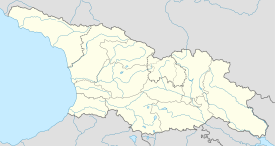Bieti Monastery
| Bieti Monastery | |
|---|---|
| Religion | |
| Affiliation | Georgian Orthodox |
| Ecclesiastical or organizational status | Active |
| Location | |
| Location | Bieti, South Ossetia/Shida Kartli, Georgia |
| Geographic coordinates | 42°11′25″N 44°12′59″E / 42.190361°N 44.216255°E |
| Architecture | |
| Type | hall church |
The Bieti Monastery (Georgian: ბიეთის მონასტერი, romanized: bietis monast'eri) is a half-ruined medieval Georgian Orthodox monastery in the historical Shida Kartli region, located near the village of Bieti in what is now the disputed territory of South Ossetia. It is built in a hall church plan and partially carved into rock. The church is inscribed on the list of Georgia's Immovable Cultural Monuments of National Significance.[1] There is another medieval Georgian church known as Bieti situated in Samtskhe-Javakheti in southern Georgia.[2]
The monastery lies on a wooded cliff in the upper Mejuda valley, a tributary of the Greater Liakhvi. Based on its architectural features and paleography of the church inscription, the building is dated to the 9th century. In historical literature it is first mentioned by Prince Vakhushti in his 1745 Description of the Kingdom of Georgia as a functioning monastery with an abbot residing there.[3]
The Bieti monastery is a hall church design, with a non-projecting apse. It is built of limestone and cobblestone and faced with sandstone slabs. The northern part of the church is cut into the adjacent rock in two tiers. A long, narrow and now-damaged annex on the south is contemporaneous with the church, while a wide hall at the southern end is a late medieval construction. Nearby are monks' cells and a refectory. The eastern façade bore an inscription in the medieval Georgian asomtavruli script, commemorating Ioane, son of Bakur Qanchaeli, "the lord and patron of this holy church". Another inscription, engraved on a small stone adjacent to the carved cross, mention Vache and Beshken, probably members of the same Qanchaeli family. Both inscriptions were, in 1912, brought for safekeeping in Tbilisi, where they are preserved at the Georgian National Museum.[2][4]
References
- ^ "List of Immovable Cultural Monuments" (PDF) (in Georgian). National Agency for Cultural Heritage Preservation of Georgia. Retrieved 25 July 2019.
- ^ a b Gamkrelidze, Gela; Mindorashvili, Davit; Bragvadze, Zurab; Kvatsadze, Marine, eds. (2013). "Bieti [ბიეთი]". ქართლის ცხოვრების ტოპოარქეოლოგიური ლექსიკონი [Topoarchaeological dictionary of Kartlis tskhovreba (The history of Georgia)] (PDF) (in Georgian). Tbilisi: Georgian National Museum. p. 111. ISBN 978-9941-15-896-4.
- ^ Wakhoucht, Tsarévitch (1842). Brosset, Marie-Félicité (ed.). ღეოღრაჶიული აღწერა საქართველოჲსა. Description géographique de la Géorgie [Geographic description of Georgia] (in Georgian and French). S.-Pétersbourg: A la typographie de l'Academie Impériale des Sciences. pp. 248–249.
- ^ Muskhelishvili, David; Tumanishvili, Dimitri; Gagoshidze, Iulon; Apakidze, Joni; Licheli, Vakhtang (2008). Skinner, Peter (ed.). The Cultural Heritage of Georgia — Abkhazeti, Shida Kartli (PDF). Tbilisi: Georgian Arts and Culture Center. p. 14. Archived from the original (PDF) on 2017-04-18. Retrieved 2019-08-17.
- CS1 Georgian-language sources (ka)
- CS1 uses Georgian-language script (ka)
- CS1 French-language sources (fr)
- Coordinates on Wikidata
- Infobox religious building with unknown affiliation
- Articles containing Georgian-language text
- Georgian Orthodox monasteries
- Georgian Orthodox churches in Georgia (country)
- Immovable Cultural Monuments of National Significance of Georgia
- Christian monasteries established in the 9th century
- Churches in South Ossetia
